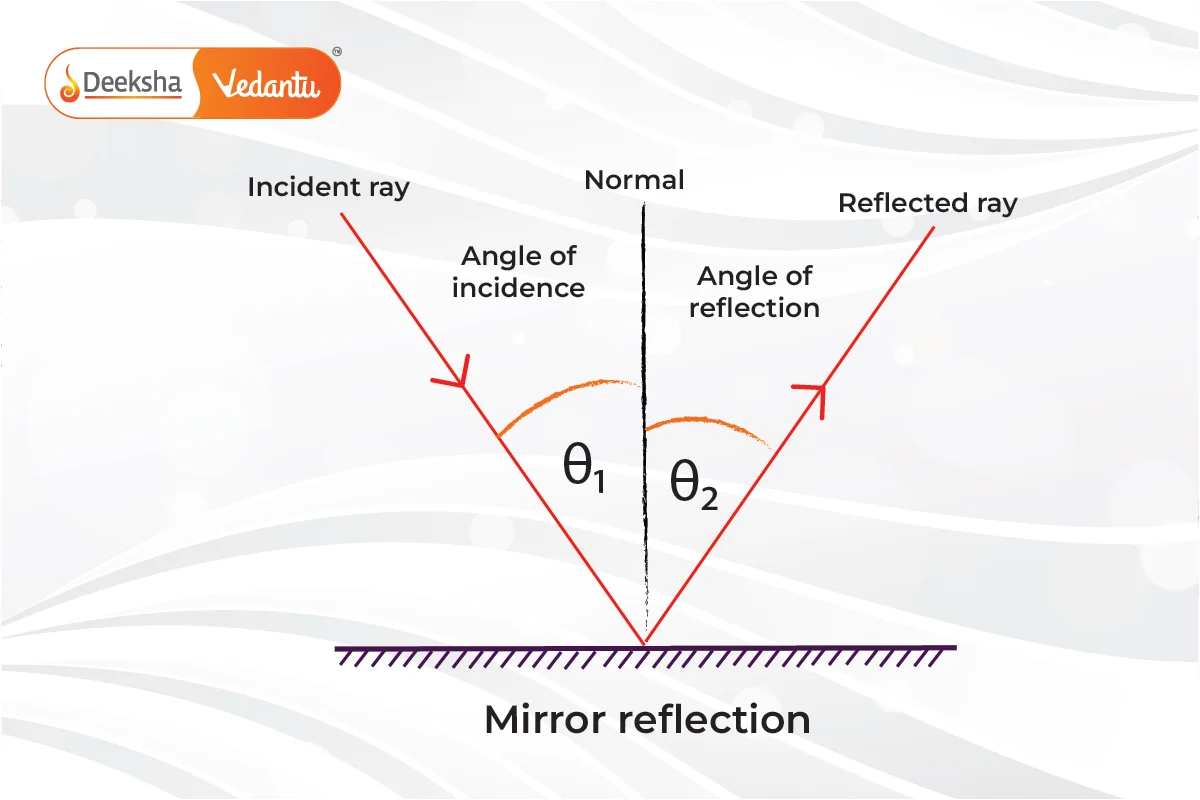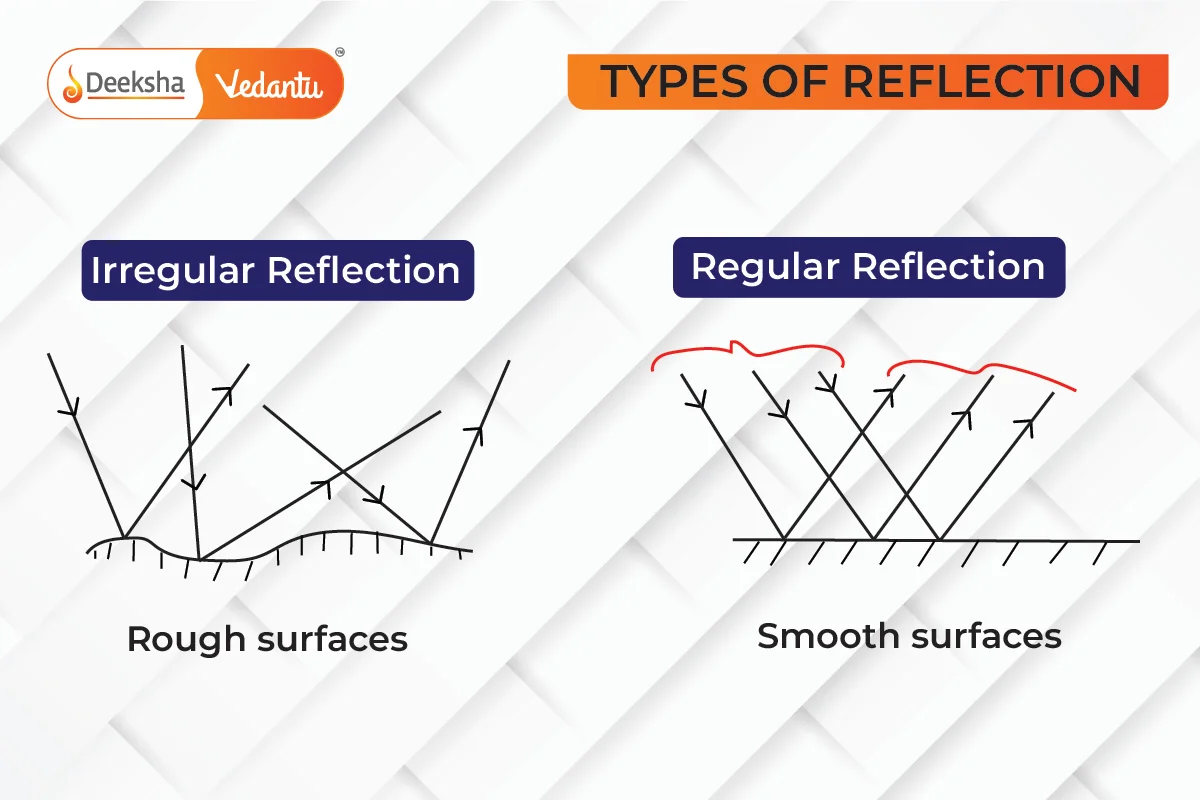Introduction
Reflection of Light is one of the most fundamental properties of light. It is the process by which light bounces off a surface rather than passing through it. Reflection helps us see objects around us as light reflects off surfaces and enters our eyes. When light falls on a smooth surface, like a mirror, it reflects in a regular pattern, following specific laws. This phenomenon is widely used in various optical devices and daily life applications.
What is Reflection of Light?
Reflection occurs when a beam of light strikes a surface and bounces back into the same medium. The amount of light reflected depends on the nature of the surface. Smooth and shiny surfaces like mirrors reflect almost all of the light that hits them, while rough surfaces scatter light in multiple directions, causing a diffuse reflection.
Laws of Reflection of Light
There are two fundamental laws of reflection that always hold true, regardless of the type of surface.
- The First Law of Reflection: The angle of incidence is always equal to the angle of reflection.
- Explanation: The angle at which light hits the surface (called the angle of incidence) is equal to the angle at which it reflects off the surface (called the angle of reflection).
- Formula:
- The Second Law of Reflection: The incident ray, the reflected ray, and the normal to the surface all lie in the same plane.
Explanation: The path of the incoming ray, the reflected ray, and the line perpendicular (normal) to the surface all lie in the same flat plane.

A simple ray diagram can be used to illustrate the reflection process:
- Incident Ray: The incoming ray of light.
- Reflected Ray: The ray that bounces off the surface.
- Normal Line: A perpendicular line to the reflecting surface at the point of incidence.
Types of Reflection
- Regular Reflection:
- Definition: When light strikes a smooth, polished surface like a plane mirror, it reflects in a single direction.
- Example: The clear image seen in a mirror is due to regular reflection. This type of reflection gives rise to distinct, sharp images.
- Diffuse Reflection:
- Definition: When light hits a rough or irregular surface, the reflected light rays scatter in multiple directions.
- Example: The reason we can see non-shiny objects, like books or walls, is because of diffuse reflection. Even though the surface is not polished, light still reflects off it but in many directions.

Key Differences:
- Regular Reflection results in a clear, sharp image.
- Diffuse Reflection does not produce a clear image because the light is scattered.
Image Formation by Plane Mirrors
A plane mirror is a flat, polished surface that reflects light regularly, and it follows the laws of reflection. Images formed by plane mirrors have the following characteristics:
- Virtual Image: The image cannot be projected on a screen because the light rays don’t actually meet but only appear to do so.
- Erect Image: The image is upright.
- Laterally Inverted: The left and right sides of the image are reversed. For example, if you raise your right hand, the image in the mirror appears to raise its left hand.
- Same Size: The size of the image is the same as that of the object.
- Distance: The image appears to be as far behind the mirror as the object is in front of it.
Example:
- If you stand 2 meters in front of a mirror, your image appears to be 2 meters behind the mirror.
Applications of Reflection of Light
- Mirrors in Daily Life:
- Used in bathrooms, cars, and for decorative purposes.
- Periscopes:
- A periscope uses mirrors to allow a person to see over or around obstacles.
- Kaleidoscopes:
- Multiple reflections inside a kaleidoscope create beautiful patterns.
- Solar Cookers:
- Concave mirrors are used to focus sunlight on a cooking pot, increasing the temperature through the concentration of reflected light.
Examples of Reflection in Real Life
- Reflection from Water: When light reflects off a calm water surface, it acts like a mirror, showing the reflection of objects like trees, buildings, or even the sky.
- Reflection from Glass Buildings: Modern glass buildings reflect light, giving a mirrored image of nearby objects or other parts of the city.
Practice Questions with Answers
Q1: Define reflection of light.
- Answer: Reflection of light is the process by which light rays bounce back from a surface into the same medium rather than passing through it.
Q2: State the two laws of reflection.
- Answer:
- The angle of incidence is equal to the angle of reflection.
- The incident ray, the reflected ray, and the normal to the surface all lie in the same plane.
Q3: What is the difference between regular reflection and diffuse reflection?
- Answer: Regular reflection occurs on smooth surfaces and results in clear, sharp images. Diffuse reflection occurs on rough surfaces, scattering light in multiple directions and does not form a clear image.
Q4: Why does a plane mirror form a laterally inverted image?
- Answer: A plane mirror forms a laterally inverted image because the left and right sides of the object are reversed in the mirror. This happens because the mirror reflects the light rays in such a way that the image appears reversed horizontally.
Q5: A light ray strikes a plane mirror at an angle of incidence of . What will be the angle of reflection?
- Answer: According to the law of reflection, the angle of incidence is equal to the angle of reflection. Hence, the angle of reflection will be
.
FAQs
A virtual image cannot be projected on a screen because the light rays do not actually meet but only appear to diverge from a point behind the mirror. A real image, on the other hand, can be projected on a screen because the light rays actually converge at a point.
Mirrors have a smooth, shiny surface that causes most of the light falling on them to be reflected back according to the laws of reflection.
Lateral inversion is the phenomenon where the left side of an object appears as the right side in its mirror image, and vice versa.
The image formed by a plane mirror is virtual, erect, laterally inverted, and of the same size as the object.
Yes, reflection occurs on all surfaces, but the nature of the reflection (regular or diffuse) depends on the smoothness of the surface.
Related Topics
- The Human Eye And The Colourful World
- Energy
- Full Wave Rectifier
- Refraction Of Light
- Laws of Motion
- Difference between AC and DC
- Domestic Electric Circuits
- Compound Microscope
- P-N Junction
- Resistance Of A System Of Resistors
- Spherical Mirrors
- Magnetic Field Due To A Current – Carrying Conductor
- Faraday’s Law
- Kirchhoff’s Law
- Atmospheric Refraction












Get Social